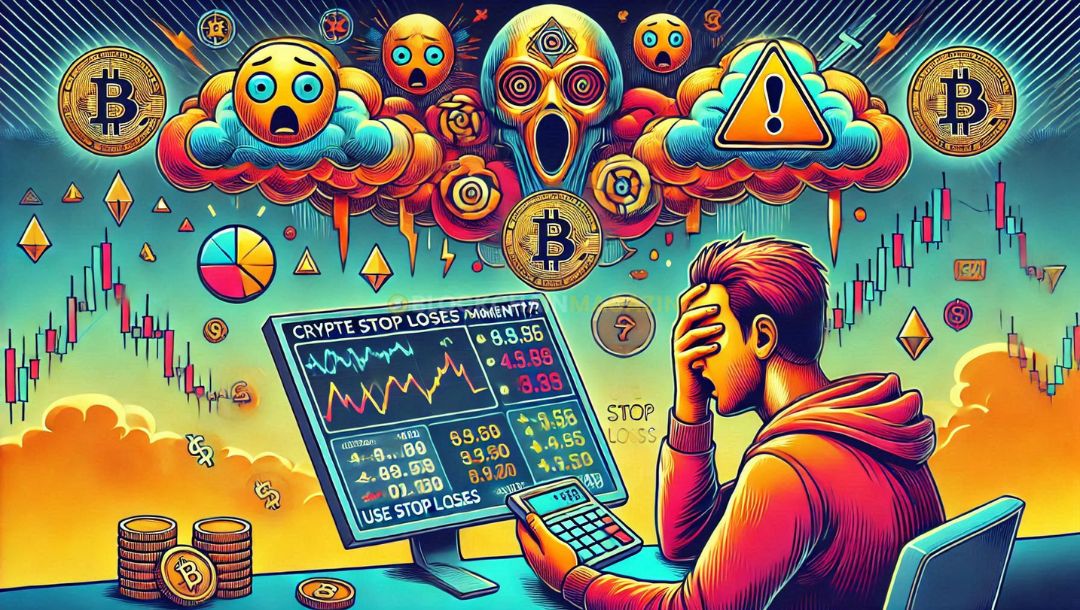Crypto Panic Moment?? Use Stop Losses While Trading
Ever felt your heart race when the crypto market takes a nosedive? You’re not alone. Many traders experience sheer panic during these times, often leading to rash decisions like selling off assets at a loss. This is where understanding crypto panic and using tools like stop losses come in handy. They can help you keep your cool and protect your investments from sudden market swings.
Key Takeaways
- Crypto panic can lead to impulsive trading decisions that hurt your portfolio.
- Stop losses are essential tools that can help prevent significant losses during market downturns.
- Recognizing the signs of a crypto panic can help you make more informed trading decisions.
- Avoiding common trading mistakes, like ignoring stop losses, can save you money.
- Developing a long-term strategy and resilient mindset can help you navigate through crypto panics.
Understanding Crypto Panic and Its Impact on Trading
The Psychology Behind Crypto Panic
Cryptocurrency markets are notorious for their wild swings, often triggering intense emotional responses from traders. When prices drop suddenly, fear kicks in, leading many to make rash decisions. Fear and greed significantly impact trading decisions in cryptocurrency, often leading to phenomena like FOMO (Fear of Missing Out) and panic selling. Understanding these psychological factors is crucial for traders to navigate the volatile market effectively. Fear, in particular, can cause traders to sell their assets at a loss, locking in losses instead of waiting for a market recovery. This reaction is often driven by loss aversion, where the pain of losing money outweighs the pleasure of gaining it.
How Panic Selling Affects Your Portfolio
When panic sets in, traders often rush to sell their assets to avoid further losses. This behavior can be detrimental to a portfolio, as selling in a panic usually means selling at a loss. For example, if you panic sell during a market dip, you might miss out on the recovery that follows. Over time, these losses add up, hurting your overall investment strategy. Additionally, panic selling can lead to missed opportunities, as the market often rebounds after a dip, leaving those who sold in a panic missing out on potential gains.
Recognizing the Signs of a Crypto Panic
Recognizing the early signs of a crypto panic can help you avoid making impulsive decisions. Look for sudden, sharp declines in market prices, increased social media chatter about impending doom, and a general sense of fear among traders. By staying informed and keeping a level head, you can better manage your emotions and make more strategic trading decisions. It’s important to remember that market fluctuations are normal, and maintaining a long-term perspective can help you weather the storm without succumbing to panic.
The Role of Stop Losses in Mitigating Crypto Panic
What Are Stop Losses?
Stop losses are like a safety net for traders in the wild world of crypto. They’re basically automatic orders set to sell your cryptocurrency once it hits a certain price. This means you can step away from the screen without worrying about a sudden market crash wiping out your investments. Stop losses help you limit potential losses, ensuring you don’t lose more than you can handle. Think of them as your trading buddy who’s got your back when things get rough.
How Stop Losses Protect Your Investments
Having a stop loss in place can be a game-changer. Imagine the market taking a nosedive while you’re busy at work or catching some sleep. Without a stop loss, you might wake up to a nightmare. But with one, your assets are automatically sold at the predetermined price, saving your portfolio from major damage. It’s like having an emergency brake on a runaway train. Stop losses protect your investments by locking in profits or minimizing losses, keeping your trading strategy on track even when emotions run high.
Setting Effective Stop Loss Levels
Setting a stop loss isn’t just about picking a random number. It requires a bit of strategy. Here are some tips to help you set effective stop loss levels:
- Avoid Psychological Levels: Don’t place your stop losses at obvious round numbers like $10,000. Whales often target these levels.
- Consider Volatility: Take into account how volatile the asset is. A highly volatile asset may need a wider stop loss.
- Use Technical Analysis: Look at support and resistance levels to determine where to place your stop loss.
Setting stop losses is not about eliminating risk but managing it wisely. It allows traders to stay in control even when the market feels unpredictable.
By using stop losses effectively, traders can navigate the unpredictable nature of the crypto market with more confidence and less panic.
Common Mistakes Traders Make During a Crypto Panic
Panic Selling vs. Strategic Selling
In the heat of a crypto panic, it’s easy to fall into the trap of panic selling. This is when traders, driven by fear, sell off their assets at a loss, hoping to avoid further declines. Panic selling often locks in losses and can lead to missed opportunities when the market eventually bounces back. On the other hand, strategic selling involves a more calculated approach, where traders sell based on predefined criteria, such as reaching a certain loss threshold or hitting a stop loss level. Strategic selling helps minimize losses while keeping emotions in check.
Ignoring Stop Losses: A Costly Error
Stop losses are designed to protect your investments by automatically selling your assets when they fall to a certain price. However, in a panic, traders often ignore or disable their stop losses, hoping the market will turn around. This can be a costly mistake, as it exposes your portfolio to potentially larger losses. By setting and adhering to stop losses, traders can mitigate the impact of rapid market downturns and avoid emotional decision-making.
Overreacting to Market Fluctuations
The crypto market is known for its volatility, with prices often swinging wildly in short periods. Overreacting to these fluctuations can lead to impulsive decisions that harm your long-term strategy. It’s important to remember that not every dip is a sign of a market crash. Instead of reacting to every price movement, traders should focus on the bigger picture and maintain a disciplined approach.
During a market panic, it’s crucial to stay grounded and not let emotions dictate your trading decisions. Remember, the market has cycles, and what goes down often comes back up.
In summary, avoiding these common mistakes during a crypto panic can help you preserve your investments and maintain a clear head. By focusing on strategic selling, respecting stop losses, and not overreacting to market movements, you can navigate the turbulent waters of crypto trading more effectively.
Strategies to Manage Emotions During a Crypto Panic
Staying Calm Amidst Market Turmoil
When the crypto market starts to tumble, it’s easy to let panic take over. But staying calm is key. Take a deep breath and remind yourself that market dips are normal. They happen all the time. Panicking only clouds your judgment, leading to rash decisions that you might regret later. Instead, focus on the facts. Look at historical data and remind yourself that the market often rebounds. If you find yourself getting overwhelmed, step away from your screen and take a break.
The Importance of a Trading Plan
Having a solid trading plan is like having a map in a storm. It guides you through the chaos and helps you make rational decisions. A good trading plan outlines your goals, risk tolerance, and strategies for different market conditions. Stick to your plan even when emotions are running high. This will help you avoid making impulsive decisions based on fear or greed. Remember, consistency is key in trading.
Using Diversification to Reduce Risk
Diversification is a strategy that can help protect your portfolio from major losses. By spreading your investments across different assets, you reduce the risk of being wiped out by a single market downturn. Consider investing in a mix of cryptocurrencies, stocks, and other assets. This way, if one investment tanks, you have others to fall back on. Diversification is not just about spreading risk; it’s about creating a balanced portfolio that can withstand market volatility.
Emotions can run high during a crypto panic, but keeping a cool head and sticking to your plan can make all the difference. Remember, the market is unpredictable, but your response to it doesn’t have to be.
Learning from Past Crypto Panics
Case Studies of Major Crypto Panics
Crypto markets have seen their fair share of panic moments. Take the 2018 crash, for example, when Bitcoin’s price plummeted from nearly $20,000 to below $4,000. Such events are often fueled by fear and uncertainty, causing a domino effect of panic selling. Understanding these events helps traders prepare for future downturns. Another instance was the 2021 dip, where Bitcoin fell below $70,000, causing widespread concern among short-term investors. Bitcoin’s price volatility highlights the importance of understanding market dynamics and liquidity.
Lessons Learned from Market Downturns
- Avoid Panic Selling: It’s tempting to sell when prices drop, but history shows that markets often recover.
- Diversify Your Portfolio: Holding a variety of assets can cushion the blow during downturns.
- Stick to Your Plan: Having a predefined strategy can prevent emotional decisions.
Adapting Strategies for Future Panics
When facing potential panic, having a solid strategy is key. Consider using stop-loss orders to limit losses. Regularly review and adjust your investment plan based on market conditions. Remember, the goal is not just to survive a downturn but to come out stronger. By learning from past events, traders can develop resilience against future market volatility.
The Influence of Social Media on Crypto Panic
How FUD Spreads Panic
In the fast-paced world of cryptocurrency, social media is like a double-edged sword. On one hand, it’s a great place to get news and updates. On the other, it’s a breeding ground for FUD—Fear, Uncertainty, and Doubt. FUD can spread like wildfire, fueled by rumors and misinformation, causing traders to panic sell and make rash decisions. When a piece of negative news hits platforms like Twitter or Reddit, it can cause a ripple effect, leading to a sudden drop in prices. This is where the psychology of herd mentality kicks in; people see others selling and feel compelled to do the same, fearing they might miss out on saving their investments.
The Role of Influencers in Market Sentiment
Influencers have a huge impact on how the market behaves. A single tweet or post from a well-known figure can sway market sentiment dramatically. These influencers often have massive followings, and their opinions can move markets. While some provide valuable insights and analysis, others might spread hype or fear, intentionally or not. It’s important to critically evaluate any information coming from influencers and not to act impulsively based on their statements alone. Remember, they might have their own agendas, and their interests might not align with yours.
Managing Information Overload
The sheer volume of information available on social media can be overwhelming. It’s easy to get caught up in the noise, especially during volatile market periods. Here are a few tips to manage this overload:
- Filter Sources: Follow credible sources and unfollow accounts that consistently spread FUD.
- Set Alerts: Use tools to set alerts for important news rather than scrolling endlessly.
- Take Breaks: Stepping away from the screen can help clear your mind and reduce anxiety.
Staying informed is essential, but drowning in information can lead to poor decision-making. Focus on quality over quantity when it comes to your news sources.
In conclusion, while social media is an essential tool for staying updated, it’s crucial to approach it with a critical eye. Being aware of how platforms can influence your trading behavior can help you avoid falling into the trap of panic-driven decisions. Remember, the market is influenced by many factors, including the hype and sentiment that social media can generate, as seen in the crypto prices affected by influencers and cycles.
Long-Term Strategies to Avoid Crypto Panic
Developing a Resilient Mindset
In the wild world of crypto, staying calm is your best friend. It’s easy to get swept up in the chaos, but maintaining a cool head can save you from making rash decisions. Emotional control is crucial in trading; staying calm helps prevent impulsive decisions. Focus on your long-term goals and try not to get distracted by the daily noise of market fluctuations. Remember, crypto is a marathon, not a sprint.
Investing for the Long Haul
When it comes to investing in crypto, patience is key. The market’s volatility can be nerve-wracking, but if you’re in it for the long haul, you’re more likely to ride out the bumps. Consider diversifying your portfolio with different types of assets, such as alternate cryptocurrencies or stock market index funds. This way, you’re not putting all your eggs in one basket.
The Benefits of Dollar-Cost Averaging
One strategy that many investors swear by is dollar-cost averaging. This involves buying or selling small amounts of your chosen asset at regular intervals. The idea here is to take emotion out of the equation and avoid the need to constantly monitor the market. While it doesn’t guarantee profits, it helps mitigate the risk of making poorly timed trades. Just keep in mind that frequent trading can lead to higher transaction costs.
Wrapping It Up: The Power of Stop Losses in Crypto Trading
So, there you have it. Trading in the crypto world can be a wild ride, full of ups and downs. But, using stop losses can be your safety net. They help you avoid those gut-wrenching moments when prices drop suddenly. Sure, it might feel like you’re giving up control, but in reality, you’re just being smart about protecting your investments. Remember, it’s not about making a quick buck; it’s about staying in the game for the long haul. So, next time the market gets shaky, keep calm, set your stop losses, and trade on. It’s all part of the journey.
Frequently Asked Questions
What is crypto panic?
Crypto panic happens when traders become very scared due to sudden drops in the market, leading them to sell their assets quickly without thinking carefully.
How can stop losses help during a crypto panic?
Stop losses are tools that automatically sell your crypto when prices fall to a certain point, helping to limit losses and protect your investments during sudden market drops.
Why is panic selling bad for my portfolio?
Panic selling can lock in losses because you might sell your crypto at a low price. If the market recovers, you might miss the chance to regain your losses.
What are some common mistakes during a crypto panic?
Common mistakes include panic selling, ignoring stop losses, and overreacting to market changes without a clear plan.
How can I stay calm during a crypto panic?
To stay calm, stick to a trading plan, avoid checking prices too often, and remember your long-term goals. Diversifying your investments can also help reduce stress.
What role does social media play in crypto panic?
Social media can spread fear and uncertainty quickly, often leading to panic. It’s important to verify information and not make decisions based solely on social media buzz.
Stay informed with daily updates from Blockchain Magazine on Google News. Click here to follow us and mark as favorite: [Blockchain Magazine on Google News].
Get Blockchain Insights In Inbox
Stay ahead of the curve with expert analysis and market updates.
latest from tech
Disclaimer: Any post shared by a third-party agency are sponsored and Blockchain Magazine has no views on any such posts. The views and opinions expressed in this post are those of the clients and do not necessarily reflect the official policy or position of Blockchain Magazine. The information provided in this post is for informational purposes only and should not be considered as financial, investment, or professional advice. Blockchain Magazine does not endorse or promote any specific products, services, or companies mentioned in this posts. Readers are encouraged to conduct their own research and consult with a qualified professional before making any financial decisions.

 Bitcoin
Bitcoin  Ethereum
Ethereum  XRP
XRP  Tether
Tether  Solana
Solana  Dogecoin
Dogecoin  USDC
USDC  Cardano
Cardano  Lido Staked Ether
Lido Staked Ether  TRON
TRON  Avalanche
Avalanche  Sui
Sui  Wrapped stETH
Wrapped stETH  Toncoin
Toncoin  Stellar
Stellar  Wrapped Bitcoin
Wrapped Bitcoin  Shiba Inu
Shiba Inu  Chainlink
Chainlink  Hedera
Hedera  WETH
WETH  Polkadot
Polkadot  LEO Token
LEO Token  Bitcoin Cash
Bitcoin Cash  Uniswap
Uniswap  Litecoin
Litecoin  Pepe
Pepe  Hyperliquid
Hyperliquid  Wrapped eETH
Wrapped eETH  USDS
USDS  Ethena USDe
Ethena USDe  NEAR Protocol
NEAR Protocol  Aptos
Aptos  Internet Computer
Internet Computer  Aave
Aave  Mantle
Mantle  Monero
Monero  Ethereum Classic
Ethereum Classic  POL (ex-MATIC)
POL (ex-MATIC)  Cronos
Cronos  MANTRA
MANTRA  Render
Render  Dai
Dai  Bittensor
Bittensor  Artificial Superintelligence Alliance
Artificial Superintelligence Alliance  Filecoin
Filecoin  Tokenize Xchange
Tokenize Xchange  Arbitrum
Arbitrum 



